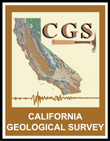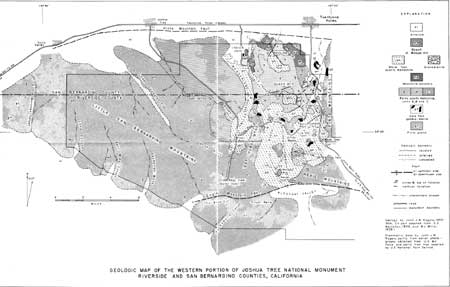
|
California Division of Mines
Special Report 68 Igneous and Metamorphic Rocks of the Western Portion of Joshua Tree National Monument, Riverside and San Bernardino Counties, California |
ABSTRACT
The western portion of Joshua Tree National Monument consists primarily of the Pinto gneiss, a metasedimentary rock unit of probable Precambrian age. The gneiss is well foliated, generally with a steep dip and north to northwesterly trend, and is composed of quartz, oligoclase, biotite, and a few minor minerals such as potash feldspar and muscovite. The gneiss is injected, particularly in the area south of Twentynine Palms, by a complex series of intrusive rocks. The oldest of these intrusive rocks is the Gold Park gabbro-diorite, which occurs in a few small, scattered bodies. Next in age is the Palms quartz monzonite, which has been subdivided into three units on the basis of slight compositional and textural differences. Along some of the contacts between Palms quartz monzoliite and gneiss is a monzonitic porphyry characterized by large (up to 6 inch) crystals of potash feldspar. The porphyry appears to have formed by reaction between the gneissic wall rock and the invading Palms quartz monzonite. From the gneiss, through the porphyry, and into the quartz monzonite there is a steady increase in the amount of potash feldspar and in the albite/anorthite ratio of the plagioclase and a decrease in the amount of mafic minerals.
The White Tank quartz monzonite (probably Jurassic) is the youngest of the major intrusive rocks and forms large, roughly circular, plutons around which the gneissic foliation is concordant. The four plutons mapped differ in mineralogy and texture. The largest one (in Queen Valley and vicinity) shows a vertical lithologic variation that is attributable to gravitative settling in a magma. Igneous activity following the White Tank quartz monzonite has formed a small body of granodiorite, minor dike rocks, and basaltic plugs.
The area is cut by three major east-west faults, the movement on which cannot definitely be determined. In many places faults occur along abrupt mountain fronts facing alluviated valleys. Valleys are also formed by differential erosion of the readily disintegrated White Tank quartz monzonite against Pinto gneiss and Palms quartz monzonite which are relatively resistant. Pediments are extensively developed along the margins of valleys in the White Tank quartz monzonite.

|
| Plate 1. (click on image for an enlargement in a new window) |
| <<< Previous | <<< Contents >>> | Next >>> |
ca/cdm-sr-68/abstract.htm
Last Updated: 18-Jan-2007